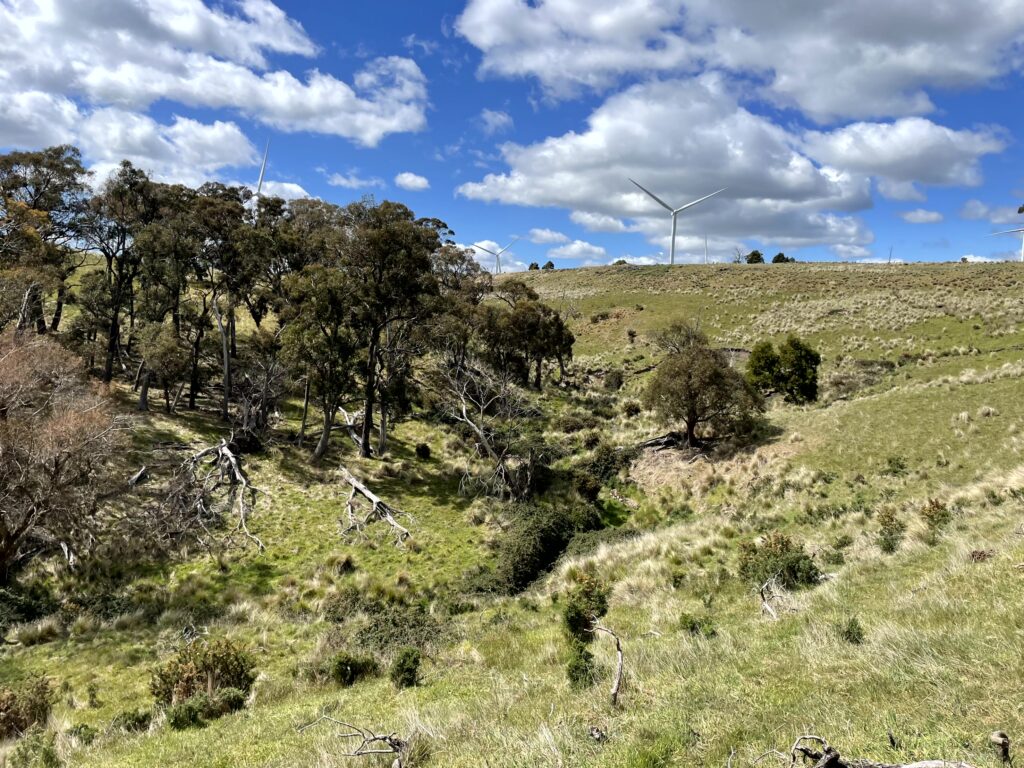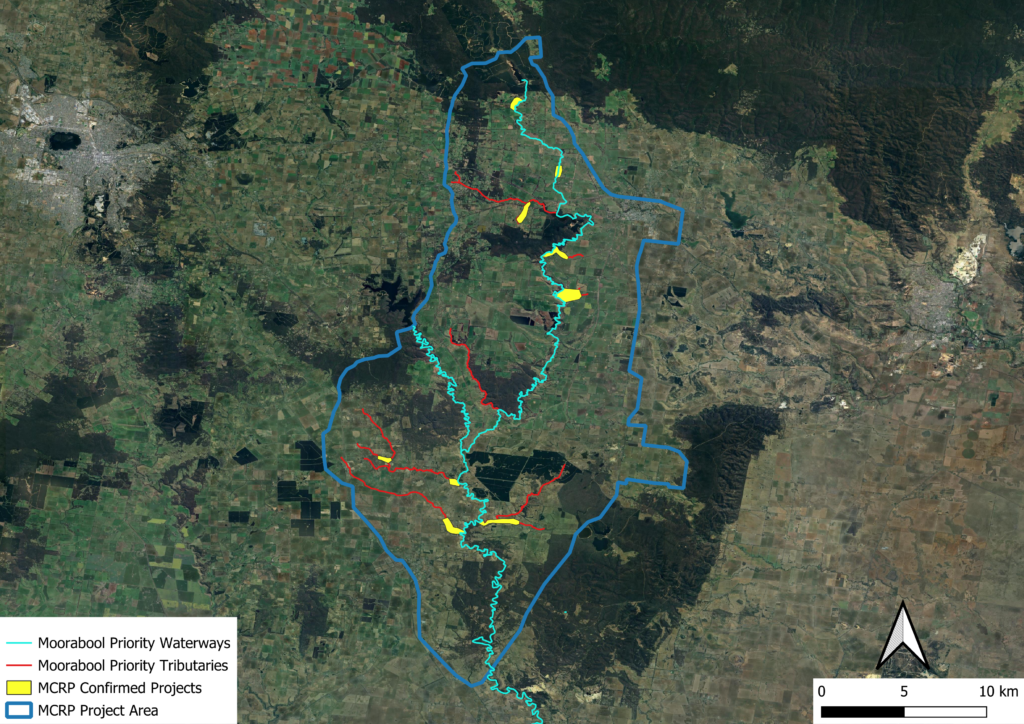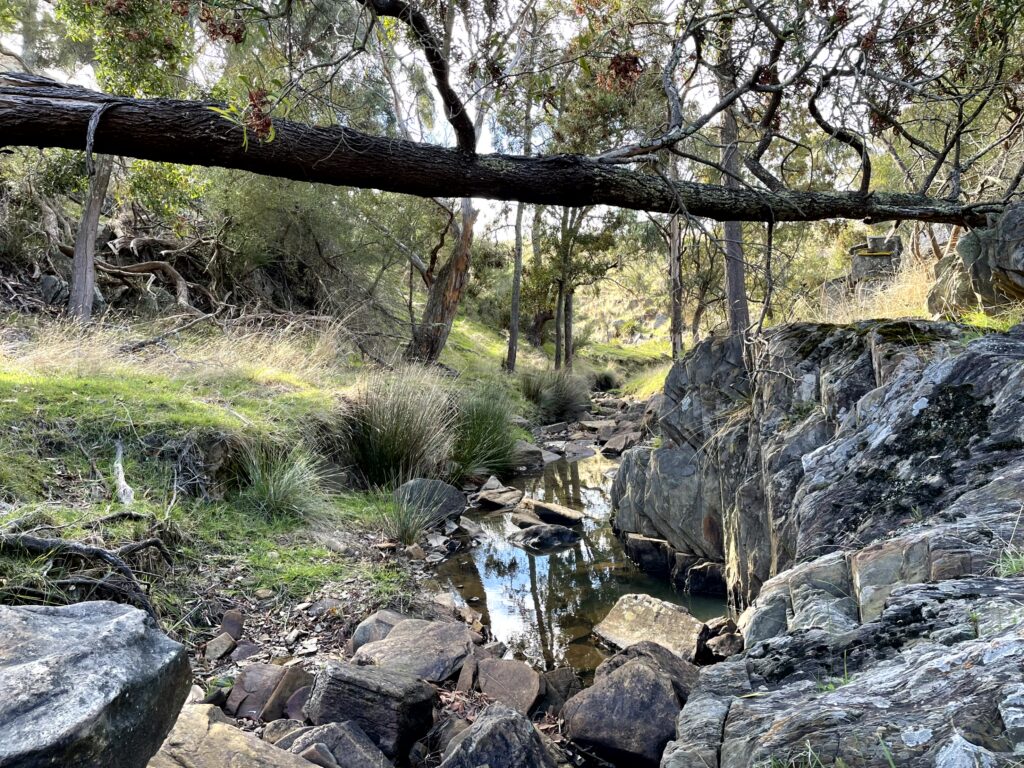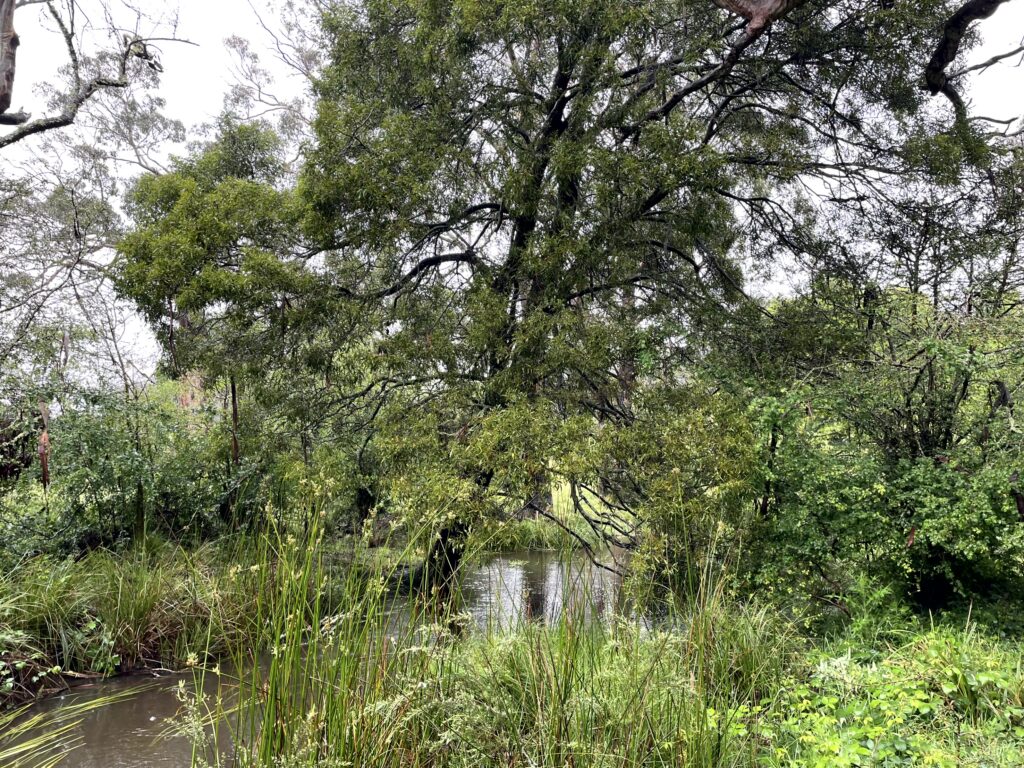Moorabool Catchment Restoration Program
A Landscape-scale Waterway Restoration Project in the Moorabool Catchment
The Moorabool Catchment Restoration Program (MCRP) is a $350,000 landscape scale waterway restoration project. The project will be delivered in the Moorabool River catchment and aims to improve water quality and riverside vegetation within the Special Water Supply Catchment. This will be done by collaborating with private landholders to undertake waterway restoration works. Restoration works will include stock exclusion fencing, weed control, pest animal control and revegetation. These initiatives aim to improve water quality, promote riparian (on the banks of the river) vegetation health, and increase community awareness of sustainable land management.
The program is a partnership between Barwon Water, Moorabool Catchment Landcare Group, private landholders, and community stakeholders, focused on creating a sustainable future for the region.
The project will deliver the following outcomes,
- Improved water quality within the Barwon Water Special Water Supply Catchment
- Improved riparian vegetation health and coverage along the Moorabool River system
- Reduction in noxious weeds along waterways in the Moorabool River system
- Increased community understanding and awareness of Special Water Supply Catchments and best practice land management
- Increased first nations capacity through NRM collaboration
The MCRP builds on previous works by the Corangamite Catchment Management Authority (CMA), Barwon Water, and the Moorabool Catchment Landcare Group. It further supports current programs delivered as part of the Corangamite CMA’s Living Moorabool Flagship Waterway project, and Kitjarra-dja-bul Bullarto langi-ut project, by supporting river health within the Moorabool and Barwon River catchments.

Project timeline
The Moorabool Catchment Restoration Program will be delivered between June 30 2024 – June 30 2028.
Target waterways
The program will target the East Moorabool, West Moorabool and Moorabool River as well as several priority tributaries to the Moorabool River system. These tributaries include,
- Eclipse Creek
- Back Aston Creek
- Tea Tree Creek
- Mirghe-Mur Creek
- Bungal Creek
- Paddock Creek
Works will not be limited to just those waterways listed above and may include any waterway in the Moorabool River system.
MCRP Project Area

The map above shows the MCRP project area, confirmed projects, as well as the priority waterways and tributaries of the project. Potential projects located on a waterway not shown on the above map will still be considered for funding and landholders are encouraged to get in touch if they are considering a waterway restoration project.
Mirghe-Mur Creek Flagship
Just outside of Meredith there is a creek that flows into the Moorabool River which is unnamed on waterway data bases. Local historians have found an original survey map of ‘The River Moorabool’ which shows this creek being named as ‘Mirghe-Mur Creek’, a Wadawurrung name. The creek is in poor condition in areas, while other areas are healthy despite pressures. There are also several cultural sites along the creek. The issues the creek faces include invasive weeds (gorse, blackberry, spiny rush, Texas needle grass, serrated tussock), erosion of creek beds, lack of native vegetation and a lack of burning causing grasslands to degrade.
Moorabool Catchment Landcare Group (MCLG) will partner with Wadawurrung Traditional Owners Aboriginal Corporation (WTOAC) and the landholders in the region to deliver an on-ground restoration program to improve the environmental and cultural values of Mirghe-Mur Creek.
The flagship aims to
- Partner with Wadawurrung
- Improve water quality
- Reduce invasive weeds
- Improve native vegetation coverage
- Deliver a cultural burn to improve ecology along creek


Want to get involved?
If you have a waterway on your property and you’re within the above project area you may be eligible for funding and support to deliver on-ground waterway restoration works. These works can include stock exclusion fencing, weed control, pest animal control and revegetation.
Not only will Moorabool Catchment Landcare Group offer financial support, but we will also offer you support through the entire project delivery and after the project finishes. Support includes organising environmental contractors, writing management plans, securing native plants, securing and ordering materials, advice and an ongoing support at the end of the project.
Steps to get involved in the MCRP
- Contact Moorabool Catchment Landcare Group.
- We conduct a desktop survey to determine whether your project is eligible for funding.
- If eligible, we organise a time to conduct a site inspection of the potential project area. Ideally the landholder is present for the inspection.
- We conduct the site inspection to determine what management actions are required. This is a great time for landholders to ask questions and explore options for their project.
- A management plan is drafted and shared with the landholder for feedback. The management plan sets out what actions will be completed during the project and how it will be done.
- Landholder enters into a funding agreement with Moorabool Catchment Landcare Group
- Project commences with ongoing support provided by Moorabool Catchment Landcare Group.
Get in touch now
You can get in touch now by calling us on 0497 770 075, emailing us at moorabool.landcare@gmail.com, or completing the below form.
Project update 7 October 2024
As of 7 October 2024 eight management plans have been drafted for potential projects as a part of the MCRP. An additional two management plans are currently being drafted with landholders. It the next couple of months landholder agreements should be signed and projects officially commencing in Summer 2024-2025.
Works for the Summer 2024-2025 period will include woody weed control of invasive species including Blackberry, Gorse, Willows and Blue Perriwinkle. We will work with landholders and provide support by providing advice on herbicide/control method selection and coordinating contractors to complete weed control.
We are also working with Wadawurrung Traditional Owners to conduct a site inspection of our Mirghe-Mur Creek Flagship area ahead of cultural burn works to be completed in 2025.
Some projects will be delivering revegetation works in Winter 2025 so we will work with our nursery partners to secure our plants for the 2025 planting season. Planting season in the Moorabool catchment is generally Jun – Sep due to favourable rain and soil moisture conditions, this can of course vary due to seasonal conditions.
Project update 28 February 2025
As of 28 February 2025 seven management plans and agreements have been signed by landholders and their projects have commenced this summer. These landholders have agreed to protect and enhance the waterways on their properties improving the health of the Moorabool River system and improving water quality in the Moorabool special water supply catchment.
These projects include managements actions such as fencing off waterways to remove stock access in Elaine, treating extensive gorse infestations in Ballan, treating severe blackberry infestations in Bolwarrah and assessing suitable areas for revegetation this Winter.
Since the MCRP first launched in July 2024 we have made great progress in getting the project off the ground and engaging with the community. The first eight months of the project has involved a lot of planning, creating governance structures, and landholder inspections and discussions. This is now paying dividends as the first round of on-ground works has commenced and plants have been ordered for revegetation in Winter 2025.
Public awareness of the project has also grown, including a two-page article being published in the Meredith News, and the MCRP landing page launched on the Moorabool Catchment Landcare website. As a result, we have three potential new projects in the planning stage and plans to begin landholder outreach in May to have additional projects come online in 2026.
Several of the current active projects have woody weed control still to be performed in March/April 2025 because of contractor availability. The bulk of the current allocated funding is for revegetation efforts which will begin to be delivered in Winter 2025
Project Update April 30 2025
Restoring Our Waterways: The Moorabool Catchment Restoration Program in Action
The Moorabool Catchment Restoration Program (MCRP) continues to make strong progress across the region, with eight active projects currently underway. In addition, four new management plans have recently been developed and shared with landholders. We’re hopeful these landholders will join the program and begin on-ground works this coming summer.
These new projects—valued at $51,000—will deliver a combination of stock-exclusion fencing, weed control, and native revegetation. Together, these activities help expand native vegetation coverage, reduce erosion, improve riparian habitat, and boost water quality across the catchment.
Spotlight on Mirghe-Mur Creek
One of the MCRP’s flagship projects is unfolding just outside Meredith on a tributary of the Moorabool River. Although this creek is unnamed in official waterway databases, local historians discovered an original survey map of the Moorabool River that identifies it as “Mirghe-Mur Creek”—a traditional Wadawurrung name.
In partnership with the Wadawurrung Traditional Owners Aboriginal Corporation (WTOAC), we’re proud to be helping restore this culturally and ecologically significant site.
Recently, the Gobata Dja team from WTOAC completed their second year of weed control at the creek. In a particularly innovative step, drone contractor Braydon Storm (Storm Spatial) used aerial spraying to target blackberry infestations on steep cliff faces that are too dangerous for manual access. We’re already seeing signs of dieback in the treated blackberry—an encouraging result.
Looking Ahead: Cultural Burning on the Victorian Volcanic Plains
Next up at the Mirghe-Mur Creek site, the Wiyn Murrup team from WTOAC is planning to deliver a cultural burn. Located within the Victorian Volcanic Plains bioregion. The site contains thick grassy biomass which is a mixture of native and introduced speciers. The burn will help clear excess growth, allowing a wider range of native species to regenerate while stimulating native grass growth which has evolved to respond to fire—boosting biodiversity and reinforcing cultural land management practices.
A site inspection with the Wiyn Murrup team was completed in late April, and we hope to carry out the burn in the coming months, pending suitable conditions. This will be the first cultural burn delivered in partnership between MCLG and Wadawurrung.
Want to Get Involved?
We’re always looking for more restoration opportunities through the MCRP. And with the Corangamite Catchment Management Authority soon launching its next Waterway Protection Program funding round very soon, now is a great time to get involved.
If you—or someone you know—owns property in the Moorabool region with a river, creek, or seasonal stream, we’d love to hear from you. You may be eligible for funding and expert support to help restore and protect your local waterway.
Let’s work together to make the Moorabool River system healthier, more resilient, and more connected—for people, culture, and nature.
Contact us today to learn more or express interest in a project.